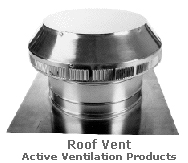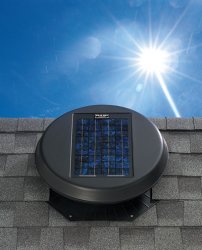attic vent
An attic vent is a passive or mechanical device used to ventilate an attic space, primarily to reduce heat buildup and moisture condensation.
Attics should be ventilated year round. In winter, attic ventilation expels moisture that might otherwise accumulate and deteriorate insulation or other building materials. Don't be tempted to seal the vents to conserve energy. Sealing them could cause costly moisture damage. In summer, proper ventilation reduces roof and ceiling temperatures thereby lowering cooling costs and extending roof life. Attic heat, which would otherwise intensify, pouring unwanted heat down through the attic floor into the living area, will escape naturally if vent area is provided.
 |
An unventilated attic can reach temperatures as high as 140°F, while allowing a path for natural ventilation lowers the temperature to a more manageable 90–100°F. Homes with poorly ventilated attics often have heat trapped in the insulation radiating into the living space late into the evening after the sun has set. Codes and practices vary, but you should plan on one square foot of free vent area for every 150 square feet of attic. A two and one quarter square foot gable vent with louvers and screening would have one square foot of free-vent area. Free-vent area can be reduced by one-half if half of the vents are low-soffit vents and half are at least three feet off the attic floor.
One of the most effective ways to ventilate a roof is the combination of a continuous ridge vent along the top of the roof with soffit vents along the sides. This creates plenty of area for the temperature differential to form, allowing warmer air to exit at the highest point in the attic. Roof vents come in a wide variety of types, some turbine-style vents even spin. Studies show the effectiveness of passive vents is about the same whether the are stationary or moveable. Power vents will draw more air out of the attic, but any energy savings attributable to them must be tempered with the fact that they use energy to operate.
Attic fan
 |
| Solar-powered attic fan
|
An attic fan is a fan mounted on an attic wall used to exhaust warm attic air to the outside. See also whole-house fan and ceiling fan.
